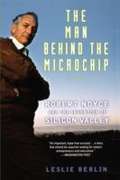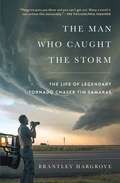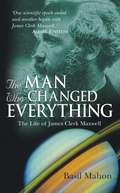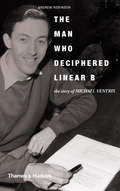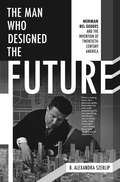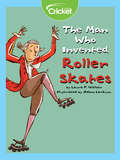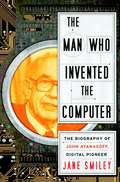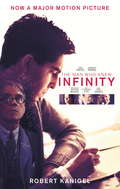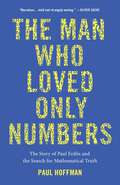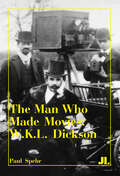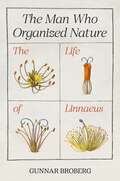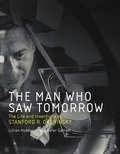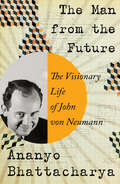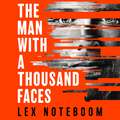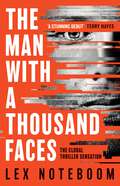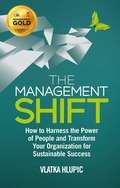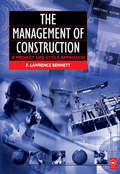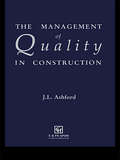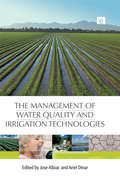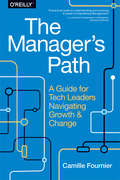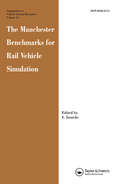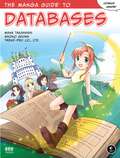- Table View
- List View
The Man Behind The Microchip: Robert Noyce And The Invention Of Silicon Valley
by Leslie BerlinHailed as the Thomas Edison and Henry Ford of Silicon Valley, Robert Noyce was a brilliant inventor, a leading entrepreneur, and a daring risk taker who piloted his own jets and skied mountains accessible only by helicopter. Now, in The Man Behind the Microchip, Leslie Berlin captures not only this colorful individual but also the vibrant interplay of technology, business, money, politics, and culture that defines Silicon Valley. Here is the life of a high-tech industry giant. The co-founder of Fairchild Semiconductor and Intel, Noyce co-invented the integrated circuit, the electronic heart of every modern computer, automobile, cellular telephone, advanced weapon, and video game. With access to never-before-seen documents, Berlin paints a fascinating portrait of Noyce: an ambitious and intensely competitive multimillionaire who exuded a "just folks" sort of charm, a Midwestern preacher's son who rejected organized religion but would counsel his employees to "go off and do something wonderful," a man who never looked back and sometimes paid a price for it. In addition, this vivid narrative sheds light on Noyce's friends and associates, including some of the best-known managers, venture capitalists, and creative minds in Silicon Valley. Berlin draws upon interviews with dozens of key players in modern American business--including Andy Grove, Steve Jobs, Gordon Moore, and Warren Buffett; their recollections of Noyce give readers a privileged, first-hand look inside the dynamic world of high-tech entrepreneurship. A modern American success story, The Man Behind the Microchip illuminates the triumphs and setbacks of one of the most important inventors and entrepreneurs of our time.
The Man Who Caught the Storm: The Life of Legendary Tornado Chaser Tim Samaras
by Brantley Hargrove“An instant classic of Americana—a story of tragedy, invention, lore, science, and a most original kind of genius.” —Hampton Sides “Masterful. This is what man versus nature is all about.” —Skip Hollandsworth The Man Who Caught the Storm is the saga of the greatest tornado chaser who ever lived: a tale of obsession and daring, and an extraordinary account of humanity’s high-stakes race to understand nature’s fiercest phenomenon.At the turn of the twenty-first century, the tornado was one of the last true mysteries of the modern world. It was a monster that ravaged the American heartland a thousand times each year, yet science’s every effort to divine its inner workings had ended in failure. Researchers all but gave up, until the arrival of an outsider. In a field of PhDs, Tim Samaras didn’t attend a day of college in his life. He chased storms with brilliant tools of his own invention and pushed closer to the tornado than anyone else ever dared. When he achieved what meteorologists had deemed impossible, it was as if he had snatched the fire of the gods. Yet even as he transformed the field, Samaras kept on pushing. As his ambitions grew, so did the risks. And when he finally met his match—in a faceoff against the largest tornado ever recorded—it upended everything he thought he knew. Brantley Hargrove delivers a masterful tale, chronicling the life of Tim Samaras in all its triumph and tragedy. He takes readers inside the thrill of the chase, the captivating science of tornadoes, and the remarkable character of a man who walked the line between life and death in pursuit of knowledge. Following the tradition of Into Thin Air and The Perfect Storm, Hargrove’s debut offers an unforgettable exploration of obsession and the extremes of the natural world.
The Man Who Changed Everything
by Basil MahonThis is the first biography in twenty years of James Clerk Maxwell, one of the greatest scientists of our time and yet a man relatively unknown to the wider public. Approaching science with a freshness unbound by convention or previous expectations, he produced some of the most original scientific thinking of the nineteenth century -- and his discoveries went on to shape the twentieth century.
The Man Who Deciphered Linear B: The Story of Michael Ventris
by Andrew Robinson"Highly readable . . . a fitting tribute to the quiet outsider who taught the professionals their business and increased our knowledge of the human past."--Archaeology Odyssey More than a century ago, in 1900, one of the great archaeological finds of all time was made in Crete. Arthur Evans discovered what he believed was the palace of King Minos, with its notorious labyrinth, home of the Minotaur. As a result, Evans became obsessed with one of the epic intellectual stories of the modern era: the search for the meaning of Linear B, the mysterious script found on clay tablets in the ruined palace. Evans died without achieving his objective, and it was left to the enigmatic Michael Ventris to crack the code in 1952. This is the first book to tell not just the story of Linear B but also that of the young man who deciphered it. Based on hundreds of unpublished letters, interviews with survivors, and other primary sources, Andrew Robinson's riveting account takes the reader through the life of this intriguing and contradictory man. Stage by stage, we see how Ventris finally achieved the breakthrough that revealed Linear B as the earliest comprehensible European writing system.
The Man Who Designed the Future: Norman Bel Geddes and the Invention of Twentieth-Century America
by B. Alexandra SzerlipBefore there was Steve Jobs, there was Norman Bel Geddes. A ninth-grade dropout who found himself at the center of the worlds of industry, advertising, theater, and even gaming, Bel Geddes designed everything from the first all-weather stadium, to Manhattan's most exclusive nightclub, to Futurama, the prescient 1939 exhibit that envisioned how America would look in the not-too-distant 60s. In The Man Who Designed the Future, B. Alexandra Szerlip reveals precisely how central Bel Geddes was to the history of American innovation. He presided over a moment in which theater became immersive, function merged with form, and people became consumers. A polymath with humble Midwestern origins, Bel Geddes’ visionary career would launch him into social circles with the Algonquin roundtable members, stars of stage and screen, and titans of industry. Light on its feet but absolutely authoritative, this first major biography is a must for anyone who wants to know how America came to look the way it did.
The Man Who Invented Roller Skates
by Laura F. NielsenRegarded as a mechanical genius, John Joseph Merlin is sadly remembered most for a party at the Carlisle House, where he careened into the hostesses' plate glass mirror, wearing his newly invented roller skates, and playing the violin.
The Man Who Invented the Computer
by Jane SmileyFrom one of our most acclaimed novelists, a David-and-Goliath biography for the digital age.One night in the late 1930s, in a bar on the Illinois-Iowa border, John Vincent Atanasoff, a professor of physics at Iowa State University, after a frustrating day performing tedious mathematical calculations in his lab, hit on the idea that the binary number system and electronic switches, combined with an array of capacitors on a moving drum to serve as memory, could yield a computing machine that would make his life and the lives of other similarly burdened scientists easier. Then he went back and built the machine. It worked. The whole world changed. Why don't we know the name of John Atanasoff as well as we know those of Alan Turing and John von Neumann? Because he never patented the device, and because the developers of the far-better-known ENIAC almost certainly stole critical ideas from him. But in 1973 a court declared that the patent on that Sperry Rand device was invalid, opening the intellectual property gates to the computer revolution. Jane Smiley tells the quintessentially American story of the child of immigrants John Atanasoff with technical clarity and narrative drive, making the race to develop digital computing as gripping as a real-life techno-thriller.From the Hardcover edition.
The Man Who Knew Infinity: A Life of the Genius Ramanujan
by Robert KanigelThe Man Who Knew Infinity is the true story of a friendship between Srinivasa Ramanujan and G.H. Hardy that forever changed mathematics. In 1913, a young unschooled Indian clerk wrote a letter to G H Hardy, begging the pre-eminent English mathematician's opinion on several ideas he had about numbers. Realising the letter was the work of a genius, Hardy arranged for Srinivasa Ramanujan to come to England. Thus began one of the most improbable and productive collaborations ever chronicled.With a passion for rich and evocative detail, Robert Kanigel takes us from the temples and slums of Madras to the courts and chapels of Cambridge University, where the devout Hindu Ramanujan, 'the Prince of Intuition,' tested his brilliant theories alongside the sophisticated and eccentric Hardy, 'the Apostle of Proof'. In time, Ramanujan's creative intensity took its toll: he died at the age of thirty-two and left behind a magical and inspired legacy that is still being plumbed for its secrets today.
The Man Who Loved Only Numbers: The Story of Paul Erdos and the Search for Mathematical Truth
by Paul Hoffman"A funny, marvelously readable portrait of one of the most brilliant and eccentric men in history." --The Seattle Times Paul Erdos was an amazing and prolific mathematician whose life as a world-wandering numerical nomad was legendary. He published almost 1500 scholarly papers before his death in 1996, and he probably thought more about math problems than anyone in history. Like a traveling salesman offering his thoughts as wares, Erdos would show up on the doorstep of one mathematician or another and announce, "My brain is open." After working through a problem, he'd move on to the next place, the next solution. Hoffman's book, like Sylvia Nasar's biography of John Nash, A Beautiful Mind, reveals a genius's life that transcended the merely quirky. But Erdos's brand of madness was joyful, unlike Nash's despairing schizophrenia. Erdos never tried to dilute his obsessive passion for numbers with ordinary emotional interactions, thus avoiding hurting the people around him, as Nash did. Oliver Sacks writes of Erdos: "A mathematical genius of the first order, Paul Erdos was totally obsessed with his subject--he thought and wrote mathematics for nineteen hours a day until the day he died. He traveled constantly, living out of a plastic bag, and had no interest in food, sex, companionship, art--all that is usually indispensable to a human life."The Man Who Loved Only Numbers is easy to love, despite his strangeness. It's hard not to have affection for someone who referred to children as "epsilons," from the Greek letter used to represent small quantities in mathematics; a man whose epitaph for himself read, "Finally I am becoming stupider no more"; and whose only really necessary tool to do his work was a quiet and open mind. Hoffman, who followed and spoke with Erdos over the last 10 years of his life, introduces us to an undeniably odd, yet pure and joyful, man who loved numbers more than he loved God--whom he referred to as SF, for Supreme Fascist. He was often misunderstood, and he certainly annoyed people sometimes, but Paul Erdos is no doubt missed. --Therese Littleton
The Man Who Made Movies: W.K.L. Dickson
by Paul SpehrThe story of W.K.L. Dickson—assistant to Edison, inventor, and key figure in early cinematography: “Valuable and comprehensive.” —Communication Booknotes QuarterlyW.K.L. Dickson was Thomas Edison’s assistant in charge of the experimentation that led to the Kinetoscope and Kinetograph—the first commercially successful moving image machines. In 1891–1892, he established what we know today as the 35mm format. Dickson also designed the Black Maria film studio and facilities to develop and print film, and supervised production of more than one hundred films for Edison.After leaving Edison, he became a founding member of the American Mutoscope Company, which later became the American Mutoscope & Biograph, then Biograph. In 1897, he went to England to set up the European branch of the company. Over the course of his career, Dickson made between five hundred and seven hundred films, which are studied today by scholars of the early cinema. This well-illustrated book offers a window onto early film history from the perspective of Dickson’s own oeuvre.
The Man Who Organized Nature: The Life of Linnaeus
by Professor Gunnar BrobergA vivid portrait of the life and work of Carl LinnaeusCarl Linnaeus (1707–1778), known as the father of modern biological taxonomy, formalized and popularized the system of binomial nomenclature used to classify plants and animals. Linnaeus himself classified thousands of species; the simple and immediately recognizable abbreviation &“L&” is used to mark classifications originally made by Linnaeus. This biography, by the leading authority on Linnaeus, offers a vivid portrait of Linnaeus&’s life and work. Drawing on a wide range of previously unpublished sources—including diaries and personal correspondence—as well as new research, it presents revealing and original accounts of his family life, the political context in which he pursued his work, and his eccentric views on sexuality.The Man Who Organized Nature describes Linnaeus&’s childhood in a landscape of striking natural beauty and how this influenced his later work. Linnaeus&’s Lutheran pastor father, knowledgeable about plants and an enthusiastic gardener, helped foster an early interest in botany. The book examines the political connections that helped Linnaeus secure patronage for his work, and untangles his ideas about sexuality. These were not, as often assumed, an attempt to naturalize gender categories but more likely reflected the laissez-faire attitudes of the era. Linnaeus, like many other brilliant scientists, could be moody and egotistical; the book describes his human failings as well as his medical and scientific achievements. Written in an engaging and accessible style, The Man Who Organized Nature provides new and fascinating insights into the life of one of history&’s most consequential and enigmatic scientists.
The Man Who Saw Tomorrow: The Life and Inventions of Stanford R. Ovshinsky (The\mit Press Ser.)
by Lillian Hoddeson Peter GarrettThe first full-length biography of a brilliant, self-taught inventor whose innovations in information and energy technology continue to shape our world.The Economist called Stanford R. Ovshinsky (1922–2012) “the Edison of our age,” but this apt comparison doesn't capture the full range of his achievements. As an independent, self-educated inventor, Ovshinsky not only created many important devices but also made fundamental discoveries in materials science. This book offers the first full-length biography of a visionary whose energy and information innovations continue to fuel our post-industrial economy.In The Man Who Saw Tomorrow, Lillian Hoddeson and Peter Garrett tell the story of an unconventional genius with no formal education beyond high school who invented, among other things, the rechargeable nickel metal hydride batteries that have powered everything from portable electronics to hybrid cars, a system for mass-producing affordable thin-film solar panels, and rewritable CDs and DVDs. His most important discovery, the Ovshinsky effect, led to a paradigm shift in condensed matter physics and yielded phase-change memory, which is now enabling new advances in microelectronics. A son of the working class who began as a machinist and toolmaker, Ovshinsky focused his work on finding solutions to urgent social problems, and to pursue those goals, he founded Energy Conversion Devices, a unique research and development lab. At the end of his life, battered by personal and professional losses, Ovshinsky nevertheless kept working to combat global warming by making solar energy “cheaper than coal”—another of his many visions of a better tomorrow.
The Man Who Went to the Far Side of the Moon: The Story of Apollo 11 Astronaut Michael Collins
by Bea Uusma Schyffert Emi GunerMichael Collins is one of the few men who has ever seen the far side of the moon. In this book, you will see the notes he wrote while flying in space, the special things he brought, and even what he ate for breakfast.
The Man from the Future: The Visionary Life of John von Neumann
by Ananyo BhattacharyaAn electrifying biography of one of the most extraordinary scientists of the twentieth century and the world he made. The smartphones in our pockets and computers like brains. The vagaries of game theory and evolutionary biology. Nuclear weapons and self-replicating spacecrafts. All bear the fingerprints of one remarkable, yet largely overlooked, man: John von Neumann. Born in Budapest at the turn of the century, von Neumann is one of the most influential scientists to have ever lived. A child prodigy, he mastered calculus by the age of eight, and in high school made lasting contributions to mathematics. In Germany, where he helped lay the foundations of quantum mechanics, and later at Princeton, von Neumann’s colleagues believed he had the fastest brain on the planet—bar none. He was instrumental in the Manhattan Project and the design of the atom bomb; he helped formulate the bedrock of Cold War geopolitics and modern economic theory; he created the first ever programmable digital computer; he prophesized the potential of nanotechnology; and, from his deathbed, he expounded on the limits of brains and computers—and how they might be overcome. Taking us on an astonishing journey, Ananyo Bhattacharya explores how a combination of genius and unique historical circumstance allowed a single man to sweep through a stunningly diverse array of fields, sparking revolutions wherever he went. The Man from the Future is an insightful and thrilling intellectual biography of the visionary thinker who shaped our century.
The Man with a Thousand Faces: The gripping, unputdownable debut from the global thriller sensation!
by Lex Noteboom'A stunning debut, more modern than tomorrow' TERRY HAYESA soldier with no name looking for a man that no one has ever seen. A student with a past she can't remember. And a husband who is a loving father... or a ruthless despot. Michelle lives a quiet life in Amsterdam with her husband Daniel and their family. But when Daniel's twin, the President of Kazichia, suddenly dies in a car crash, Daniel has no choice but to return home for the first time in twenty years, and Michelle follows along.From the moment they arrive, Daniel is pressured to succeed his brother as President. Kazichia, a former Soviet state, has been ruled by his family for three generations, and now that the throne is empty, the country is left teetering on a knife-edge.As tensions begin to rise, Michelle feels more and more that they should flee. But when an anonymous rebel leader - known only as The Man With a Thousand Faces - initiates a full-blown attack, Daniel decides to step in. But will he be able to lead the country through the crisis? And if he does, will he be able to give up his newfound power? Or will Michelle lose her husband to his own hunger for greater political reign?In a world of fake news and big data, lines between fiction and reality are blurred. And the mythical figure behind it all is THE MAN WITH A THOUSAND FACES.
The Man with a Thousand Faces: The gripping, unputdownable debut from the global thriller sensation!
by Lex Noteboom'A stunning debut, more modern than tomorrow' TERRY HAYESA soldier with no name looking for a man that no one has ever seen. A student with a past she can't remember. And a husband who is a loving father... or a ruthless despot. Michelle lives a quiet life in Amsterdam with her husband Daniel and their family. But when Daniel's twin, the President of Kazichia, suddenly dies in a car crash, Daniel has no choice but to return home for the first time in twenty years, and Michelle follows along.From the moment they arrive, Daniel is pressured to succeed his brother as President. Kazichia, a former Soviet state, has been ruled by his family for three generations, and now that the throne is empty, the country is left teetering on a knife-edge.As tensions begin to rise, Michelle feels more and more that they should flee. But when an anonymous rebel leader - known only as The Man With a Thousand Faces - initiates a full-blown attack, Daniel decides to step in. But will he be able to lead the country through the crisis? And if he does, will he be able to give up his newfound power? Or will Michelle lose her husband to his own hunger for greater political reign?In a world of fake news and big data, lines between fiction and reality are blurred. And the mythical figure behind it all is THE MAN WITH A THOUSAND FACES.
The Management Shift: How to Harness the Power of People and Transform Your Organization for Sustainable Success
by Vlatka Hlupic<p>Research shows that corporate life expectancy and performance have declined 75% in the last 50 years - organizations need a different approach if they are to survive, let alone thrive. <p>While people are often stated as a company's greatest asset, few businesses have a clear model of leadership that improves engagement, removes barriers to innovation, and uncovers hidden strengths in people and the organization. This book addresses that need and, more importantly, demonstrates HOW organizations can make The Management Shift to a new way of thinking and working. Professor Hlupic argues that organizations now need to adopt a leadership style that focuses on people, purpose and knowledge sharing, creating new types of value and ultimately improving innovation and engagement - leading to improved business. <p>Based on leading-edge research supported by numerous case studies, which demonstrate the power and impact of change, The Management Shift offers managers a practical and systemic approach to diagnose leadership issues in their organization. It then provides an implementation process to shift their mindset and organizational culture to the new level of thinking, performance, and ultimately business success.</p>
The Management of Construction: A Project Lifecycle Approach
by F. Lawrence BennettManagement of Construction introduces all aspects of management practice to students and professionals based in the construction industry. It is also important for those involved in allied fields such as design, project development, and site monitoring and inspection. The book addresses each stage of the construction project from conception to completion, giving a perspective on the whole life cycle often missing from textbooks. The author also balances engineering concerns with the human resource and personal aspects of construction management that are so important to the successful outcome of a project.
The Management of Enclosed and Domesticated Deer: International Husbandry Systems and Diseases
by John FletcherThis is the first book devoted to international deer husbandry techniques for the growing industries of venison, velvet antler, and antler trophy production as well as long established extensive park systems for amenity. Written by world leaders in their specialised subjects, chapters shed light on widely differing management systems and the optimum design of deer farms, handling yards and fencing layouts. Moreover, readers will discover the requisites of good stockmanship and specialist veterinarians describe different diseases the deer may develop. Details on available treatments, the general biology of deer and an explanation of controversial ethics of velvet and trophy production complete this work.As deer farming has come of age this collection is timely. At fifty years the New Zealand deer industry carries one million animals with annual venison exports to America, Europe and growing antler markets in China and Korea. Chinese antler production is well-established and Asian reindeer husbandry even more ancient. In North America and Europe, deer are now being kept for antler trophies and amenity in many historic parks. This volume is a valuable resource for everyone researching deer management systems, be it practising veterinarians, deer farmers, park managers or agricultural and veterinary students.
The Management of Quality in Construction
by J.L. AshfordThe quality of a product or service is a measure of its ability to satisfy customer requirements. This satisfaction can be assured by the operation of a quality system which will ensure that specified requirements are met consistently and economically. The Management of Quality in Construction provides the reader with a knowledge of the principles of quality management and an understanding of how they may successfully be applied in the particular circumstances of the construction industry. The areas covered range from an historical review of traditional methods of assuring quality in the industry and how contractual arrangements have evolved, to an interpretation of quality system standards in the context of construction. Examples are given which highlight specific areas, and specialist chapters on organization structures and the techniques of quality auditing are included.
The Management of Technology and Innovation
by Margaret White Garry D. BrutonIn today's economy the management of technology is a major factor in the process layout employed by the firm, in systems used by the company, in its structural design, and in its product marketability. This text uses technology as a guiding focus for explaining the strategic management process. Each chapter splits into two acts: (1) chapters open with material synthesized from leading theorists and consultants; (2) chapters conclude with discussions of the applicable techniques for successfully exploiting technology and innovation.
The Management of Water Quality and Irrigation Technologies
by Ariel Dinar Jose AlbiacThis book is an outcome from the International Expo 'Water and Sustainable Development' held in Zaragoza (Spain) in 2008. Support from the Spanish Ministry of Environment, Caja Rioja, Government of Aragon, and the World Bank is acknowledged. 'Few resources will play a more important role in shaping our economic future, or face more daunting challenges, than water. This internationally acclaimed team of experts has produced a first-rate volume that is full of intriguing, practical ideas for meeting those challenges in a rich variety of institutional settings.' Tom Tietenberg, Mitchell Family Professor of Economics, Emeritus, Colby College, USA 'This volume brings together two critical but interrelated dimensions of water challenge, i.e. water pollution, particularly from non-point sources, and water conservation. The editors are well known experts on the subject as are the contributors.' R. Maria Saleth, International Water Management Institute, Sri Lanka and Associate Editor, Water Policy 'The profound contribution of this volume is that it brings together various economic concepts and policy dilemmas regarding water shortages, non-point source pollution, efficiency of water use and irrigation technology. Recommended reading for anyone working in the area of water management.' Henk Folmer, University of Groningen and Wageningen University, The Netherlands As countries face deteriorating water and environmental quality as well as water shortages, pollution control and the efficiency of water use become of paramount importance. Agriculture is one of the main non-point polluters of water bodies and irrigation for agriculture is one of the main consumers of water. While it is very hard to regulate pollution from agriculture, attempts have been made via economic and command and control instruments, and also through investments in technologies and ecosystems recovery. Coping with non-point pollution takes the form of both policy intervention and technology development. Likewise it is recognized that irrigation efficiency varies across countries, influenced by both technology and supporting adoption policies. Countries that lead in irrigation technology and supporting policies have certain traits in common. They face very high scarcity and are pushed to find innovative solutions, both technical and policy related. The recent multibillion investments in irrigation technologies in Spain, and similar proposals in Australia, for example, highlight the potential of irrigation technologies to cope with scarcity and water quality degradation. This book reviews all of the above issues, presents experiences in selected countries, and assesses the degree of success of alternative policies for coping with non-point water pollution and improving irrigation efficiency.
The Manager's Path: A Guide for Tech Leaders Navigating Growth and Change
by Camille FournierManaging people is difficult wherever you work. But in the tech industry, where management is also a technical discipline, the learning curve can be brutal—especially when there are few tools, texts, and frameworks to help you. In this practical guide, author Camille Fournier (tech lead turned CTO) takes you through each stage in the journey from engineer to technical manager.From mentoring interns to working with senior staff, you’ll get actionable advice for approaching various obstacles in your path. This book is ideal whether you’re a new manager, a mentor, or a more experienced leader looking for fresh advice. Pick up this book and learn how to become a better manager and leader in your organization.Begin by exploring what you expect from a managerUnderstand what it takes to be a good mentor, and a good tech leadLearn how to manage individual members while remaining focused on the entire teamUnderstand how to manage yourself and avoid common pitfalls that challenge many leadersManage multiple teams and learn how to manage managersLearn how to build and bootstrap a unifying culture in teams
The Manchester Benchmarks for Rail Vehicle Simulation
by S. IwnickiThis volume contains the results of the Manchester Benchmarking exercise for railway vehicle dynamics simulation packages. Five of the main computer packages currently used for this purpose were examined in the exercise and the results are presented in the form of tables and graphs.
The Manga Guide to Databases
by Mana Takahashi Shoko Azuma Co Ltd TrendWant to learn about databases without the tedium? With its unique combination of Japanese-style comics and serious educational content, The Manga Guide to Databases is just the book for you.Princess Ruruna is stressed out. With the king and queen away, she has to manage the Kingdom of Kod's humongous fruit-selling empire. Overseas departments, scads of inventory, conflicting prices, and so many customers! It's all such a confusing mess. But a mysterious book and a helpful fairy promise to solve her organizational problems—with the practical magic of databases.In The Manga Guide to Databases, Tico the fairy teaches the Princess how to simplify her data management. We follow along as they design a relational database, understand the entity-relationship model, perform basic database operations, and delve into more advanced topics. Once the Princess is familiar with transactions and basic SQL statements, she can keep her data timely and accurate for the entire kingdom. Finally, Tico explains ways to make the database more efficient and secure, and they discuss methods for concurrency and replication.Examples and exercises (with answer keys) help you learn, and an appendix of frequently used SQL statements gives the tools you need to create and maintain full-featured databases.(Of course, it wouldn't be a royal kingdom without some drama, so read on to find out who gets the girl—the arrogant prince or the humble servant.)This EduManga book is a translation of a bestselling series in Japan, co-published with Ohmsha, Ltd., of Tokyo, Japan.
